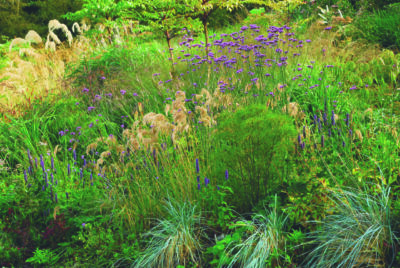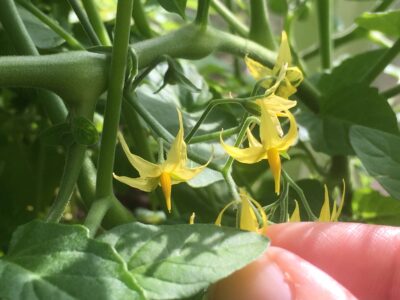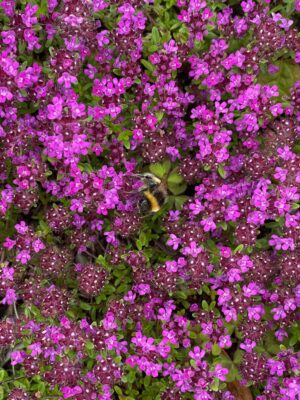Our gardens really do have a route into our mind, body and souls.

I don’t know about you but I simply love to lose myself in the garden or in nature. It’s something that I have always done and I didn’t realise it was a kind of meditation or mindfulness. There is something about escaping into nature with or without a purpose. Sometimes there’s a task to do that you can concentrate on and give all your attention to. Other times it’s more a case of noticing the minutiae of nature, far from trivial details, the incredible world that is beneath our feet and around us, is brim-full of fascinating life all interconnected and intricate.

I suppose I am at risk of ridicule, but don’t mock it if you haven’t tried it. At the very least, be aware of how you feel when you exit the mad world you live in and enter into your garden or indeed into nature. It can be an instant calming effect. Factor in a tree canopy and the cool of shade in summer, the fragrance of scented plants, or freshly cut grass and the mesmerising sound of birdsong or even buzzing bees, and your guided meditation has not just started, it’s delivered you to the pivot point. The place where you connect with whatever energy or state of mind you are seeking. The fact that you can just teleport yourself to this place is not just amazing, it’s healing too and if you can hone that effect, imagine being in that peaceful place you really can access it when you are not there by simply using your imagination. Try it. You might be surprised.

But there are other ways of training your brain to be calm and quiet. Many use different forms of distraction and in effect this is what mindfulness does. You simply focus on the precious present. It’s not a gold watch or an expensive bottle of perfume, the precious present it right now. You concentrate on what you are doing and nothing else matters. You can simply focus on our breathing. Or the birdsong. Or something else that you can zone into. Or you can carry out repetitive tasks that don’t need too much deliberation, but that allow you to distract your mind. Here are a few of my distraction techniques.
Deadheading the flowers

If you want your plants to keep flowering, especially your flowering annuals, it’s a good idea to deadhead them. That means removing any spent blooms. The idea is that the plant needs to make seed, so by removing the dead flowers and seed head you force it to make more flowers. A sharp pair of snips and a basket to collect the deadheads and you are ready for action. All you do is concentrate on the plant and its flowers and gently snip off any that are past their best. Repeatedly. Again, and again.
Harvesting

One of my favourite summer tasks is picking raspberries. It was my job as a child to collect these fragrant fruits from our allotment, every day. So, the smell of fresh raspberries takes me right back to being twelve and picking bucketloads out on the allotment. And the repetitive action of picking each fruit carefully, inspecting it and adding it to the harvest bowl is a ritual and a gentle form of meditation. I can totally focus on just doing that and it takes me away from whatever it is in the world that I am struggling with. You might be picking beans, or cutting leaf salad, or something similar. Make it a meditation and train your mind to refocus on the minutiae of it.
Pollinating

While my garden bees do the majority of the pollination, in my greenhouse the tomatoes get neglected. Commercial tomato growers, growing under glass buy in bumblebee nests to pollinate their crops. Tomatoes need bumblebees to effect the buzz pollination technique that releases the tightly held pollen. I don’t want bumblebees trapped in my glasshouse so I prefer to pollinate them by hand. I simply hold the pollen rich anthers and rub them between my finger and thumb releasing the pollen. When there are hundreds of flowers it can take an age to pollinate them all and that is perfect for five or ten minutes of mindfulness. Plus, you get tomatoes! So, it’s a win, win, win!
Focus on sound and movement

Sound is another way to refocus your brain. Zone in to the bird song, the sound of grasses moving in the wind, or the buzz of the bees and you can absorb yourself in the healing sounds of nature.
Or you might find watching the birds bathing in the bird bath, the bees feeding on the flowers, or a moving garden sculpture oscillating in the breeze another way to tune into another realm. Anything that captures your attention and allows you to concentrate on something other than life’s challenges and questions.
Often your brain will interrupt, but keep practicing. Just five seconds at a time helps to train your mind and gradually you will be able to increase your attention span and quiet that voice in your head.
Find your own way

Once you get the hang of it you can apply mindfulness to all sorts of garden activities, from sowing seeds to pricking out and pruning. And of course, it works with other things too. What do you do to distract your mind and refocus your brain? Whatever it is, keep doing it and do more.










